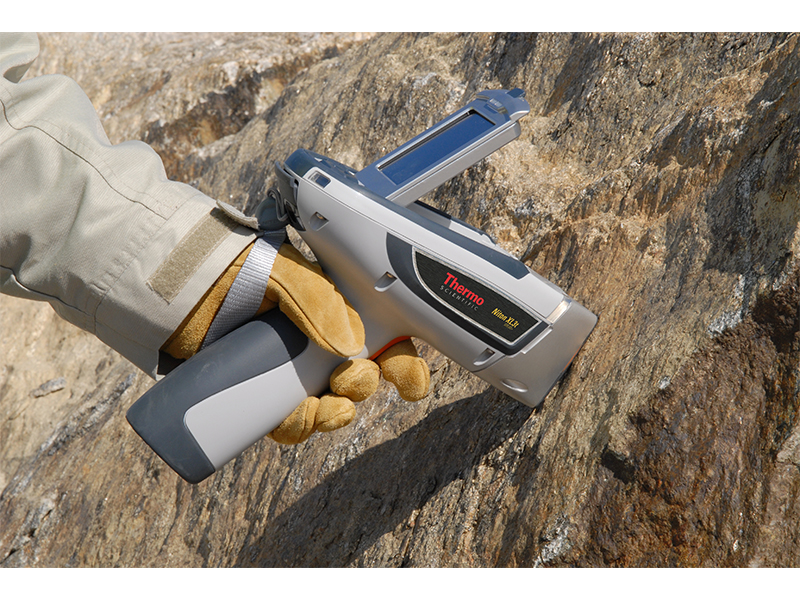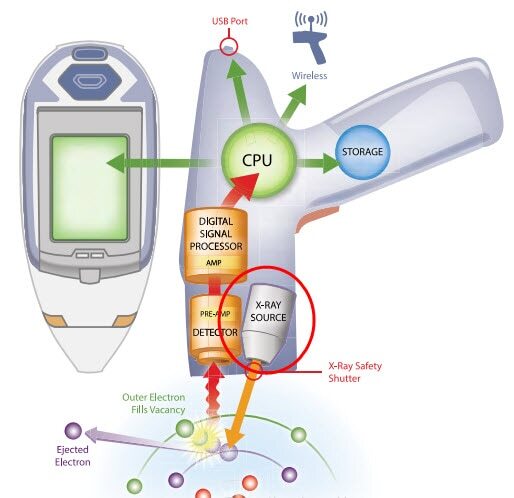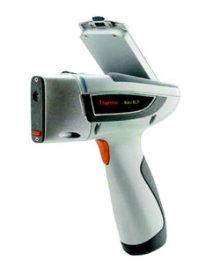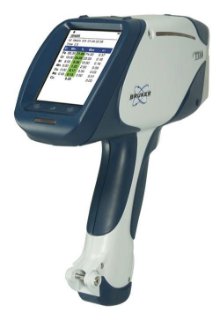What is XRF Testing?

What is XRF Testing?
Look on the wonders of Petra, Jordan, an ancient city carved out of sandstone. What secrets lie within? Archaeologists ask the same question, but they go a little deeper than the over 1 million tourists who visit the site each year—into the very stone itself.
XRF testing is a technique that harnesses the power of x-ray fluorescence. With XRF, researchers gain insight into what the stone is made of, how old it is, even where it came from, down to the smithy where the tools were forged that chiseled out its famed pillars. You can find test personnel firing XRF guns at samples in everything from archaeology to alloy fabrication, mining, identifying precious metals, inspecting consumer goods, and art conservation.
To understand modern XRF testing, however, you need to know what an XRF gun is.
What is an XRF Gun?
An XRF gun is a non-destructive tool designed to perform elemental analysis on materials. XRF guns, formally called XRF analyzers or XRF machines, perform measurements by harnessing the power of X-ray fluorescence (XRF), specifically what is called energy dispersive x-ray fluorescence (EDXRF). The XRF gun fires x-rays at the sample under test, causing the sample to emit fluorescent x-rays, and each element reacts by releasing a unique ‘fluorescent fingerprint’. XRF analyzers capture these identifying fluorescent signals. Once the measurement is taken, the gun identifies the contributing elements and gives a comprehensive report of the sample’s elemental composition._25.jpg)
A user can perform an XRF analysis in mere seconds, thanks to the speed of EDXRF technology and the simple point-and-shoot functionality of portable XRF equipment. XRF guns are also lightweight, handheld devices, some weighing as little as 3 lbs (1.36 kg), that can nonetheless perform laboratory-grade analysis. This makes them invaluable in remote field applications.
XRF devices inspect everything from minerals to fluids over a measurement range spanning from magnesium (MG) to uranium (U).
- They inspect both major elements: Si, Ti, Al, Fe, Mn, Mg, Ca, Na, K, P
- And trace elements: Ba, Ce, Co, Cr, Cu, Ga, La, Nb, Ni, Rb, Sc, Sr, Rh, U, V, Y, Zr, Zn
Silicon Drift Detector (SDD) XRF Guns
- Newer, more expensive, more sensitive
- Ideal for measuring light elements (Mg, Al, Si, P, S, etc.)
- Generally takes 1-2 seconds to identify elements
- Designed for high count-rate & high sensitivity applications
- Older, less expensive, less sensitive
- Only sensitive to heavier elements, specifically those higher on the periodic table than Sulfur (S)
- May take longer, up to 8-10 seconds, to perform analysis
How XRF Analysis Works
- A user fires an XRF gun at a sample.
- Now stimulated by x-rays, the sample displaces inner-shell electrons, and outer-shell electrons take their place. This is due to energy differences between the x-ray beam and the energy holding the electrons in orbit. The test sample generates x-ray fluorescence as a result.
- The XRF gun receives the fluorescent x-ray emissions, converts them to electrical pulses, and sends the pulses to an internal preamplifier.
- The preamplifier sends the XRF signal to a digital signal processor.
- The processor converts the x-ray measurements to a digital format and transfers the spectral data to the XRF gun’s CPU.
- The CPU performs compositional analysis on the data.
- The XRF gun displays the results, which are stored in the unit’s memory and can be transferred to an external computer.

Photo credit to Thermo Fisher Scientific
What is XRF Analysis Used For?
XRF analysis is used for a variety of quality control and chemistry-specification inspection applications. Any situation in which the elemental breakdown of a sample is needed is ideal for a handheld XRF gun, given that: 1) the sample is roughly > 1 gram, 2) the sample is made homogenous so there are consistent results no matter where you test, and 3) there are official testing standards to aid with measurement and keep the operator safe.Here are some common applications:
Archaeological inspection (Archaeometry)
- X-ray fluorescence is used in archaeology as a non-destructive way to determine the chemical composition of artifacts. Archaeologists need to know everything from the soil composition at an Egyptian dig site to the age of ancient Roman denarii - and XRF is often key to their discoveries.
Fabricating alloys
- Fabrication shops use XRF guns to ensure their work product consists of the intended metal alloys, giving inspectors a surefire quality assurance method more reliable than the average test report.
Recycling alloys and metals
- The metal recycling industry, especially scrap metal businesses, rely on XRF machines for:
- Quick & accurate sorting of metals
- Guaranteeing the right metal is sent to customers, and the quality of the metal
- Determining the elemental composition of the scrap (does it have contaminants, hazardous elements, etc.)
Precious metals
- For jewelers, an XRF instrument detects metals that are non-standard, under-karated, or counterfeit, and cannot be deciphered by standard methods like acid testing.
Positive material identification (PMI)
- Positive material identification, or PMI, both prevents part failures in the field due to wrong alloy use and verifies end products.
Geology & mining
- X-ray fluorescence testing helps mining companies to make vital decisions like where to focus on a mining site, when to drill, when to select a sample, and whether to relocate equipment. Mining personnel use XRF products on everything from phosphate and limestone, and even for discovering indications of oil and gas in rock surfaces.
Environmental/soil remediation
- This NDT technique is used in environmental testing to determine if there are harmful elements like lead in living or working facilities. Soil contamination is another environmental threat an XRF analyzer can discover, warning users of lead, arsenic or chromium found in a soil sample.
Analyzing art for conservation applications
- Art historians and conservationists analyze old paintings, ceramics, furniture, and more with XRF. XRF data gives them clues into the geographical location of the specific materials crafting the piece, helps them match colors exactly during restoration projects, and aids dealers in authenticating valuable works of art.
Product inspection for consumer goods
- X-ray fluorescence testing can be used to verify compliance with the Consumer Product Safety Improvement Act of 2008 (CPSIA), which calls for testing to determine if there are dangerous elements like lead in toys, clothes, electronics, and other consumer goods. XRF guns are also used to ensure compliance with the RoHs, which regulates how electronic products are manufactured.

